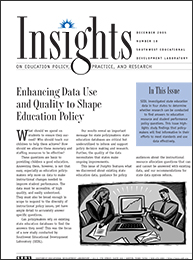SEDL Study on State Data Systems
Findings from our 2003 policy study, Examination of Resource Allocation in Education: Connecting Spending to Student Performance, served as the basis for our current study on state education databases. These findings for Arkansas, Louisiana, New Mexico, and Texas are below:
- High-performing school districts put more fiscal and staff resources into instructional areas than do low-performing districts.
- Districts with increasing student achievement use data-driven decision making to support resource allocation.
In discussions with policymakers about these results, they asked for greater detail on instructional resources linked to student performance. To pursue this, our latest study, Investigation of Education Databases in Four States to Support Policy Research on Resource Allocation, examined Arkansas, Louisiana, New Mexico, and Texas education data collected and managed by the four state education agencies to determine whether research can be conducted to find these links.
Do state databases allow the investigation of the relationship between fiscal and staff instructional resources and student performance?
Our goal was to understand the scope, quality, and availability of each state’s data to support its instructional resource decisions. Specifically, we addressed the question, Do state databases allow the investigation of the relationship between fiscal and staff instructional resources and student performance?
Four years of state instructional expenditure; staff characteristic; student performance; and student, school, and district characteristic data were the focus of our study. We assessed how the four states utilize their data and determined state-specific policy concerns by the following:
- Examining public reports, summaries, and research
- Discussing data management with state education staff and other state policymakers
- Reviewing state policy
After identifying key variables, we assembled and examined the data for usability on five criteria:
States have been consistent over time in their categorization and collection of instructional expenditures.
- Availability and accessibility
- Completeness
- Accuracy
- Consistency
- Alignment
Next, we gauged commonalities across the state data and performed descriptive statistics to assess data quality. An important last step was to meet with state policymakers to discuss our findings and formulate ideas for data system reform specific to their state.
Next Page: The State of State Education Data

